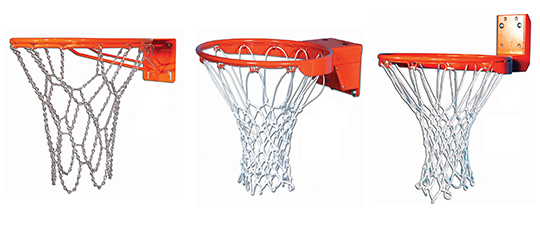Although it is one of the easiest and least expensive components of your basketball system to replace, the rim (also known as a goal) plays an important part in determining the level of play on your basketballs system.
Fixed Rims
A fixed rim is stationary, without a mechanism to allow for movement. Fixed rims are a popular, budget-friendly option for virtually any basketball system used for recreational play. However, fixed rims can cause undue stress on the backboard if continuous dunking occurs, possibly leading to board damage or breakage. In addition, fixed rims are not approved for competition high school, collegiate, or professional levels of play.
Understanding the anatomy of a fixed rim is the first step in choosing the correct fit for your needs. As you add rings, ring diameter, and strengthen the bracing, you’re building a stronger rim. Single ring fixed goals are the most economical style of fixed goals and are versatile for indoor and outdoor use. For heavier play environments such as parks or playgrounds, a double ring goal comprised of two rings and double braces will provide even more strength and durability.
Fixed rims are most commonly offered with a “pigtail” net attachment for use with a nylon net. Those facilities concerned with hand injury from the pigtails may want to consider a T-tie or bumped ring net attachment, where there are no additional pieces of steel hanging underneath the ring. For urban and rugged play settings, a steel chain net is a smart choice due to its increased durability and longevity over nylon.
Breakaway Rims
First invented in 1976, breakaway rims are now the rim of choice for competition play settings in high schools, universities, and professional arenas all over the world. Breakaway rims contain a spring mechanism which allows the ring to bend downward when under pressure and come back up when the pressure is released. As basketball has evolved to include dunking as an integral part of the game, breakaway rims are now more important than ever before to prevent stress on backboards (especially glass boards) and preserve their longevity.
Breakaway rims are generally available in several different styles, for competition or recreational use. Traditional competition breakaway rims have a one-way positive lock breakaway action where the rim “breaks” at the front of the goal, but facilities with larger budgets and high energy dunkers may opt for a multi-directional rim that break on the sides as well. In addition, mechanisms with more springs and higher pressure settings (the force applied that causes the rim to “break”) will be better suited for highly skilled players and more intense play levels. The most advanced breakaways, designed for professional and collegiate play settings, will contain three springs and 180+ lbs. pressure settings, while the more popular breakaways for high school and junior high use will typically have two springs and approximately 160 lbs. pressure settings.
Regarding net attachment, advanced breakaway rims will almost always have tube tie or tie cord net attachments, where the net is internally attached to the rim without attachment pieces hanging down and potentially causing hand injuries. Standard breakaways typically include the popular pigtail net attachment, although concerns for safety have caused some manufacturers to offer the tube tie attachment across the board for all breakaway models.
Recreational breakaway rims, on the other hand, are generally used in outdoor settings, such as public parks or playgrounds. While competition breakaways are only offered with one ring per NBA, NCAA, and NFHS rules, recreational breakaways are also available with double rings for added strength to withstand heavy play. In addition, most recreational breakaways are offered with two springs in the mechanism to stand up to play in schools, rec centers, and public courts, while breakaways with one spring are best suited for residential play environments.
Rear-Mount Rims
Rear-mount rims are a popular choice for recreational play settings, generally for outdoor use. Rear-mount rims have an “L” shaped backplate that connects to the backboard from behind, making it the strongest board and rim configuration available. In addition, the rear-mount design increases the lifespan of the backboard by placing all the stress of a dunk onto the post instead of the board and by eliminating damage to the protective powdercoating on the board’s front. For facilities who wish to use a rear-mount setup, there are many styles to choose from. Single-ring fixed rear-mount rims are an affordable option for light play settings, while double-ring breakaways may be a better choice for facilities with public outdoor courts and heavy play environments where excessive dunking will occur. However, it is important to note that rear-mount rims must be used in conjunction with rear-mount boards due to their unique design. Unfortunately, this means that fewer backboard material and shape options are available for consumers.

